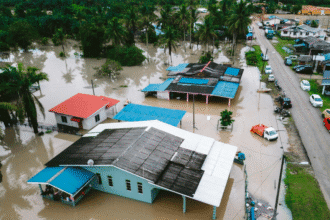Just two days after a 5.2-magnitude earthquake killed more than 1,400 people and hurt thousands more in Afghanistan, a strong aftershock hit eastern Afghanistan. The new tremor, which was centered near Jalalabad in Kunar province, made it even harder for rescuers to do their jobs in the isolated, hilly area. The first earthquake, which had a magnitude of 6.0, did a lot of damage and buried whole settlements in debris. Rescue teams are still working to get to people who are still stranded by flying helicopters over dangerous terrain. The Taliban-led administration has asked for urgent help from other countries, and several have sent humanitarian aid.
Where did the aftershock hit?
At 12:29 local time, the aftershock happened. Its epicenter was around 34 kilometers from Jalalabad, Afghanistan’s fifth-largest city. The United States Geological Survey reported that the quake was only 10 kilometers deep, which made it more likely to cause damage. There have been no fresh deaths or damage to buildings, but people in the Sawkai district and other regions felt the ground shake severely again. Here is the link to our article on the Naples earthquake evacuation.
What problems are rescue crews having?
Landslides generated by the first earthquake in Afghanistan have made it much harder for rescue workers to do their jobs. In many circumstances, airlift is the only choice because blocked roads make it hard to go about on the ground. Helicopters are being utilized to get injured people out of distant settlements, but these flights have also been hard. In one case, a helicopter had to stop trying to land in the Mazar valley because the ground was too treacherous.
How are people who survived the disaster dealing with it?
Survivors have told horrifying stories about the night of the earthquake. One woman said that when she woke up in the dark, she found her house ruined and numerous family members buried. She lost her daughter-in-law and eight grandkids. Another father said that he had to dig up his deceased children by himself in utter darkness because no one else was around to help.
Doctors in Jalalabad are taking care of people who have serious injuries. Medical professionals have established that about half of the patients who were admitted are women, and many of them had injuries to their heads, spines, or limbs. Some needed surgery right away, while others are still waiting for care since there aren’t enough resources. Here is the link to our article on the Myanmar earthquake summit.
What has the rest of the world done?
Many countries and groups have promised to help with the earthquake in Afghanistan. The UK has promised £1 million in humanitarian aid, and India has sent 1,000 tents and is sending 15 tons of food to the areas that need it. Switzerland and China have also offered help. To make sure the help gets to the right people quickly, trustworthy partners like the United Nations Population Fund and the International Red Cross are working together to coordinate it.
Why is this problem worse now?
Afghanistan is already living through one of its greatest humanitarian crises, which is getting worse because of the severe drought and widespread hunger. The earthquake in Afghanistan happened at a time when international aid was already low, notably from major donors like the United States. This cut in support is making it tougher for relief efforts to satisfy the needs of the people who have been affected. The country’s weak infrastructure and lack of healthcare resources are also making things harder.
Final Thoughts
The recent Afghanistan earthquake and the strong aftershock that followed have exposed the country’s limited capacity to handle disasters. With thousands dead and injured, and aid flows remaining insufficient, urgent global assistance is critical to prevent further loss of life. It is essential to maintain international attention on Afghanistan’s challenges as rescue and recovery operations continue.








